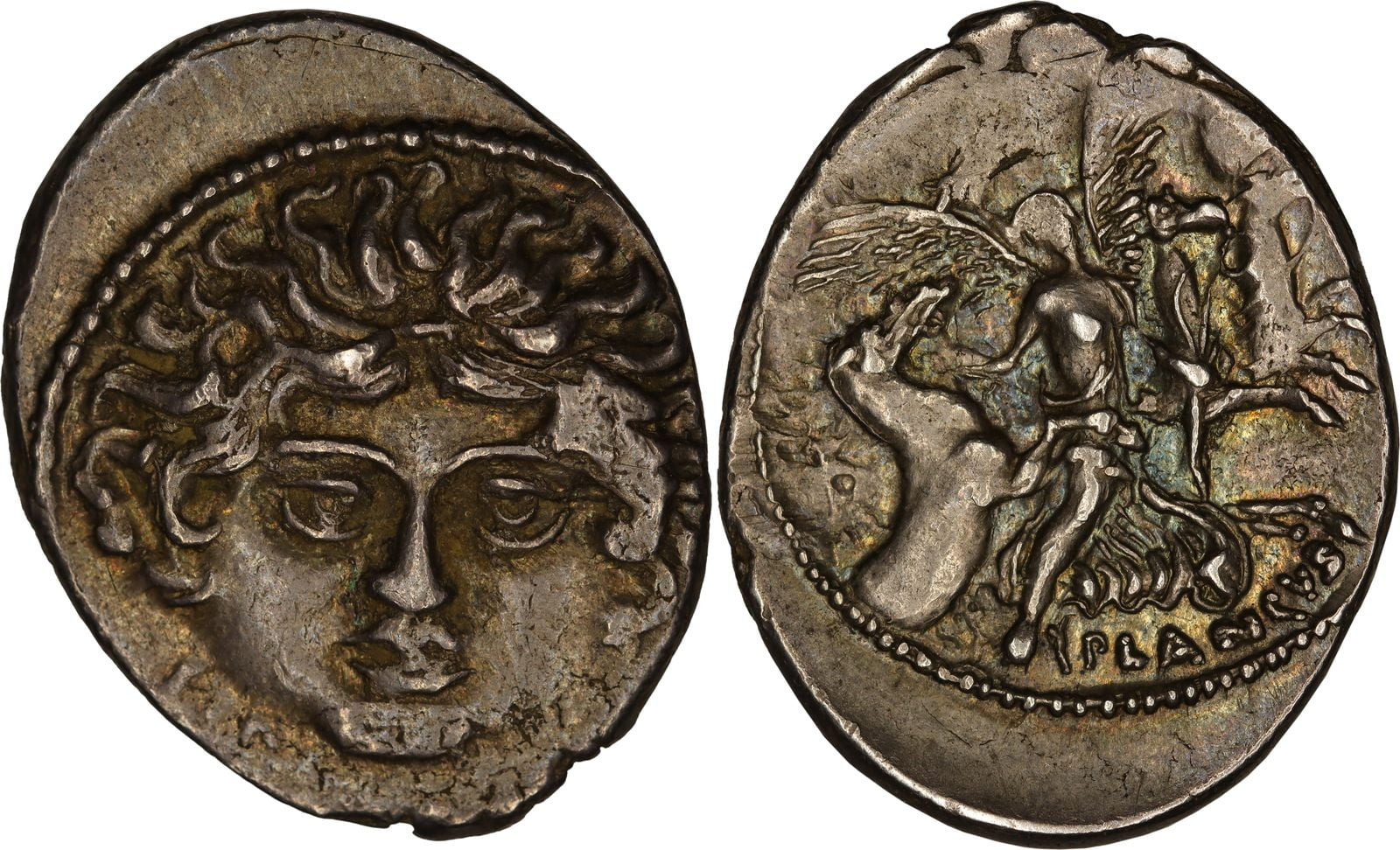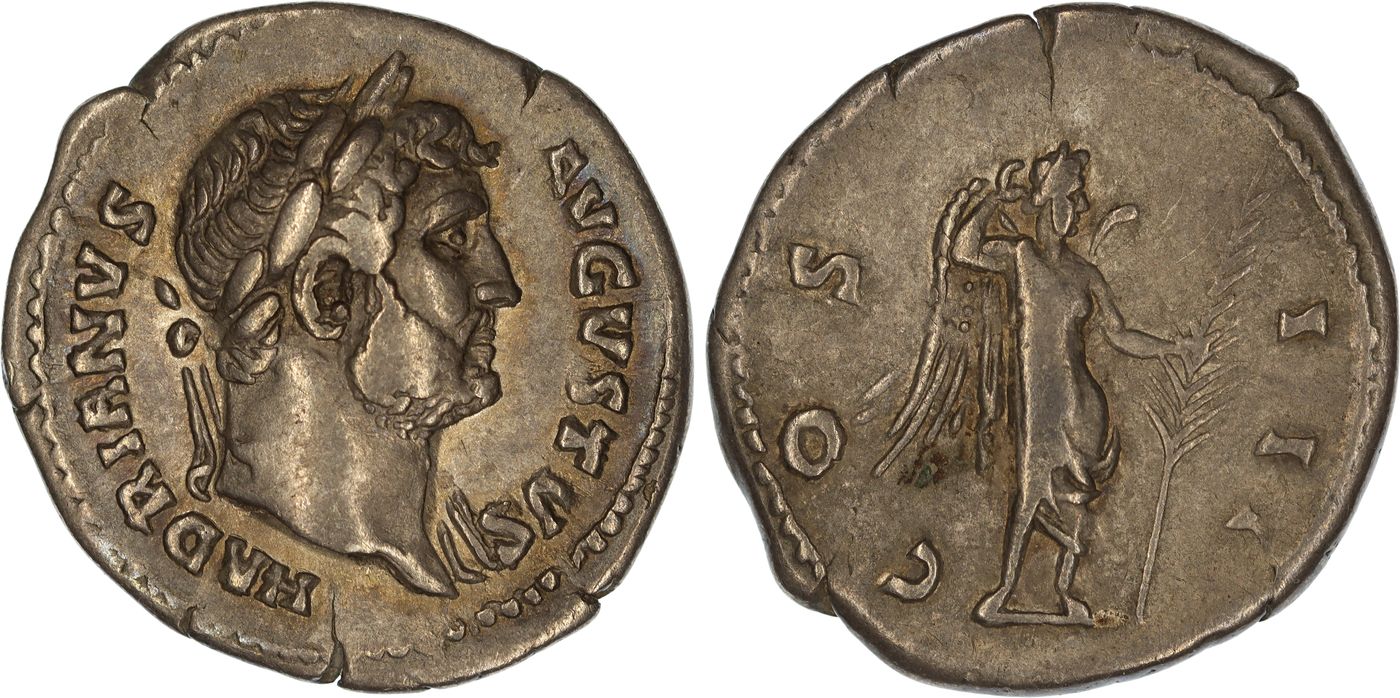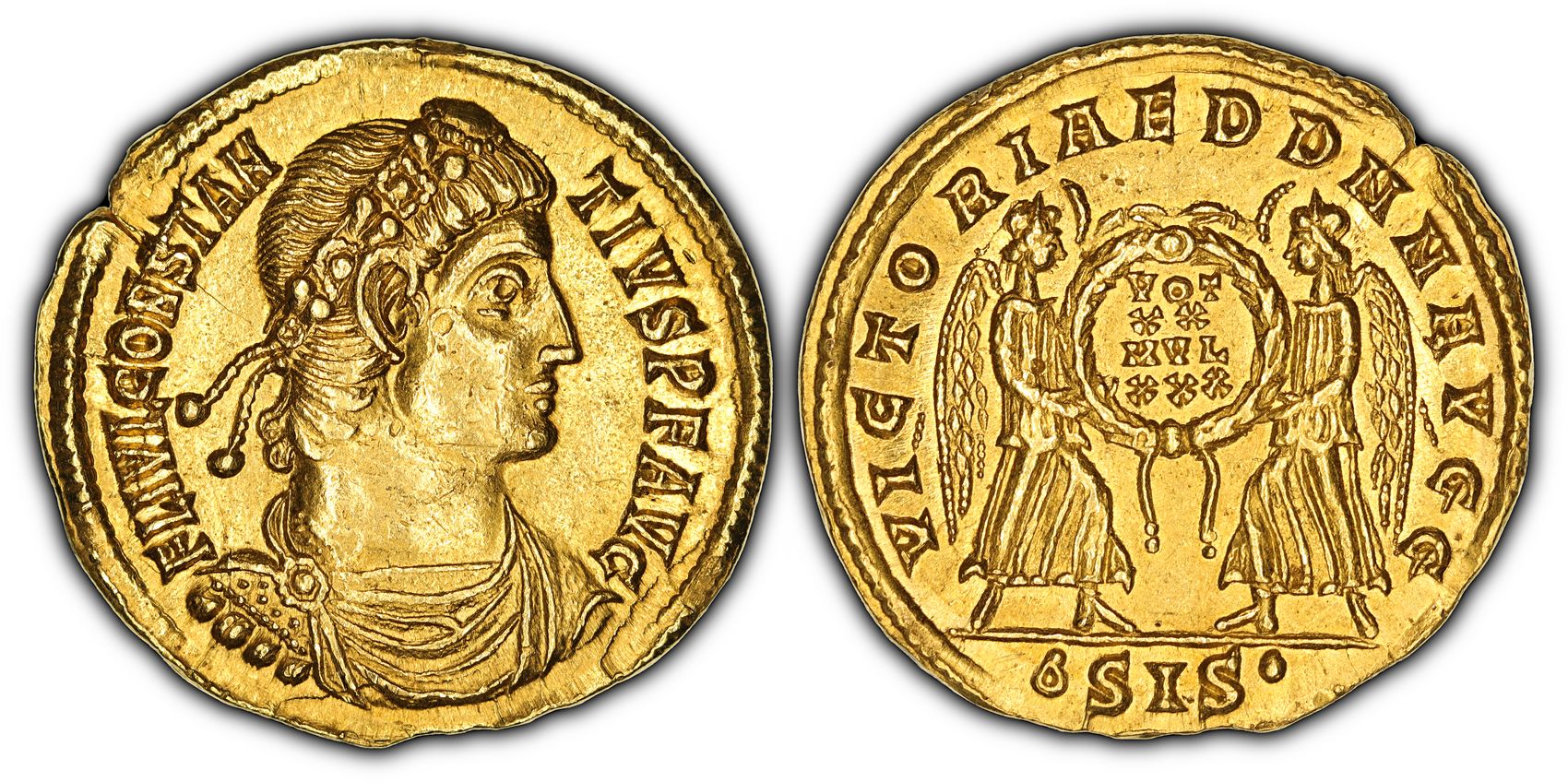An Interpretation of ‘Victory in a Quadriga’ on a Silver Denarius

Lucius Plautius Planchus, Moneyers of Imperatorial Rome 49-27 BC, Silver Denarius (3.93g, 22mm), Rome mint 47 BC. Obverse: Head of Medusa facing forward, “L PLAVTIVS” below. Reverse: Victoria stands right, head facing forward, her wings spread wide whilst conducting four rearing horses – a Roman interpretation of ‘Victory in a Quadriga’ by Nichomachus of Thebes, “L PLANCHVS” below. Sear-329; RSC Plautia-14-15a.
Sold to a Brisbane Gentleman, and is now part of an extensive Ancient Roman Collection.
Victoria and Nike
The Goddess Victoria (‘Victory‘ in English) was the personification of victory in all forms, and was the Roman interpretation and equivalent to the Greek Goddess Nike. Although the concept of victory was certainly important to both cultures, Victoria seems to have had greater reverence to the Romans from a numismatic perspective – although the Ancient Greeks of the late Classical and Hellenistic period did portray Nike on their coinage, she is often an accompany figure to a second, central god or goddess, primarily being held aloft by Zeus or Athena as an epithet, ‘Zeus Nikephoris’ or Zeus the victorious or bringer of victory. On the other hand, Victoria is freqently engraved in bold design as a central figure on the reverses of Roman coinage, either by commanding a biga or quadriga on early Republican silver, standing as a central figure on the reverse or imperial coinage, or the central figure on the gold solidii of early Byzantine coinage before transitioning to an angel. Further to numismatically, Victoria had multiple temples erected specifically in her honour and had frequent portrayal in jewelry, architecture and other art forms.

Gnaeus Cornelius Cn.f. Lentulus Clodianus, Moneyers of the Roman Republic, Silver Denarius (3.51g, 16.5mm), Rome mint 88 BC. Obverse: Helmeted bust of Mars wearing Corinthian helmet, seen from behind with head turned right, spear over left shoulder and parazonium over right shoulder, denomination mark below chin. Reverse: Victoria commanding biga to the right, holding reins in left hand and wreath in right hand raised, “CN·LENTV[L]”. Sear-254; RSC Cornelia-50.

Caesar Traianus Hadrianus, Roman Emperor of the Nerva-Antonine Dynasty 117-138 AD, Silver Denarius (3.22g, 19mm), Rome mint 125-128 AD. Obverse: Laureate bust of Hadrian facing to the right, slight drapery over far left shoulder, legend surrounds, “HADRIANVS AVGVSTVS”. Reverse: Victoria stands facing to the right, draped and holding long palm in left hand and holding head with right, legend surrounds, “COS III”. Sear-3480; RIC-182; RSC-358.
The Obverse Latin legend reads “Hadriānus Augustus”, naming Hadrian as Augustus. The Reverse Latin legend reads “cōnsulāritās tertium”, with an English translation of “honoured with the office of Consul for his third term”.

Flavius Julius Constantius, Augustus of the Constantinian Dynasty 337-361 AD, Gold Solidus (4.46g, 22mm), Siscia mint 346-348 AD. Obverse: Rosette-diademed, draped and cuirassed bust of Constantius II facing to the right, legend surrounds, “FL IVL CONSTANTIVS PF AVG”. Reverse: Two Victoria stand facing one another, holding a laurel wreath shield between them bearing the inscription “VOT XX MVL XXX”, mintmark “SIS” preceded by “O” surmounted with dot and followed by single dot in exergue, outer legend surrounds, “VICTORIAE DD NN AVGG”, . RIC-109; Depeyrot-8/1. Captivating in its appearance, this attractive gold solidus of Flavius Julius Constantius aptly captures the elegance and beauty of Constantinian numismatics – the archetypical diademed portraits of the late Roman Empire is showcased here in its standard powerful and inspiring fashion, whilst also showcasing the new naming of ‘Pius Felix’ used during the Dominus Period. The reverse displays a busy yet beautifully clear message – Victoria stands doubled, the Victory of the Emperor, holding up his Votis and Multis. Good Extremely Fine, and scarce.
The Obverse Latin legend reads “Flavius Julius Constantius, Pius Felix, Augustus”, translating to “Flavius Julius Constantius, the Pius and Blessed, Augustus (Emperor)”. The Reverse Latin legend reads “Victoriae Dominorum Nostrorum Augostorum”, translating to “Victories to our Lords the Augusti”. Within the laurel shield bears the Latin inscription which reads “Votis Vicennalibus Multis Tricennalibus”, translating to “Vows/Prayers for the Twentieth Reign Anniversary and More for the Upcoming Thirtieth Anniversary”. The Votis and Multis types became popular during the Dominus Period, or ‘Dominate’, and were widely used during the Constantinian Dynasty; the term ‘Dominate’ is inspired by the use of Dominus Noster (“D N”) as part of the emperor’s official titulature first under Diocletian, a stark difference to his predecessors of the ‘Principate’. Of note, the term Dominus, ‘Lord’, was first used on the coinage of Aurelian as “deus et dominus natus”, or “God and born ruler” – a powerful title akin to his famous ‘Restitutor Orbis’ series – the ‘Restorer of the World’.

Leo I ‘the great’, Eastern Augustus of the Leonid Dynasty 457-474 AD, Gold Solidus (4.19g, 20mm), Constantinople mint 462-466 AD. Obverse: Pearl-diademed, helmeted and cuirassed bust of Leo I facing forward, head turned slightly to the right, wielding spear and shield; his weapon extends behind and his shield, which is decorated with a horseman motif, rests on his left shoulder, legend surrounds, “DN LEO PERPET AVC”. Reverse: Victoria stands facing to the left, holding long jewelled cross in right hand, star to inner right field, mintmark and purity “CONOB” in exergue, legend surrounds, “VICTORIA AVCCC Z”, . RIC-605; Depeyrot-93/1.
The obverse Latin legend reads “Dominus Noster, Leo, Perpetuus Augustus”, with an English translation of “Our Lord, Leo, the perpetual Augustus”. The reverse Latin legend reads “Victōria Augustōrum” followed by the 7th officina letter “Z”, with an English translation of “Victory of the Augusti”.
An explanation for this could be the slight differences in their spheres of influence – although each deity personified victory in all forms, Victoria also represented the reasoning behind who would be victorious during war, and as a result victory over death itself (the act of resisting Mors, the personification of death itself). On the other hand, the Greeks tended to associate the concept of why one was victorious in battle with the concept of wisdom and strategy, concepts personified by the Goddess Athena – he who had the blessings of Athena would be deemed the victor. This idea is also corroborated by how important Athena was in Greek society, and the pervasive portrayal of this deity in art, architecture and numismatics.
Imperatorial Rome: Lucius Plautius Plancus
Struck at Rome in 47 BC in the name of the Lucius Plautius Plancus, a Roman Republican moneyer, this silver Denarius is a perfect example of Victoria on a numismatic piece – featured with her wings spread in full splendour, she conducts a triumphant quadriga, a symbol in which she is often presented with during the Republican period. The defining elegance displayed by the reverse design has led many to believe it to be a re-interpretation of the famous artwork aptly named by the Romans as ‘Victory in a Quadriga’, a painting by the ancient Greek painter Nichomachus of Thebes in the 4th Century BC. It is likely that this famous painting was in possession of the Plancus family, or at least witnessed first hand by the moneyer at the time of this denarius’ minting in 47 BC, as it was later moved to Rome by Lucius Munatius Plancus following his Gallic triumph in 43 BC. Although the coin itself is captivating in its own right, the design is all the more important as the original painting, much like the rest of Nichomachus’ work, has been lost to time.
Although Lucius Plautius Plancus is mostly known as a moneyer during the Imperatorial period, his aforementioned brother left a far greater legacy. Lucius Munatius Plancus served in many political positions during the turbulent time of Imperators, most notably as Praefectus Urbi under Gaius Julius Caesar in 45 BC and as proconsul of Gallia Comata in 43 BC after Caesar’s assassination. Plancus revealed himself as a master of non-committance and is most famously a classic historical example of a man who have managed to survive very dangerous circumstances by constantly shifting their allegiances. He is one of the very few important Roman historical figures whose tomb has survived and is identifiable, although his body has long since vanished, and his funerary inscription attests an immense legacy in life. Of note, Munatius Plancus played a major role in the founding of Lugdunum (modern day Lyon), an important Roman city in the Gallic region and a major mint for extensive coinage series such as Augustus’ bull series or Tiberius’ Pontif Maxim series, as well as the city of Augusta Raurica, the oldest Roman colony on the Rhine river. Also, it is said that on the 16th of January 27 BC, Munatius Plancus proposed the title Augustus, translated as “revered one” in English, be granted to the Imperator Octavian; the title would adopted by Octavian and incorporated in his official nomenclature, becoming Imperator Caesar Augustus.


Leave a Reply
Want to join the discussion?Feel free to contribute!